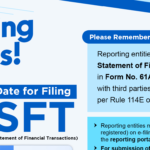Using Data Analytics to Improve Tax Filing Processes in India
Introduction: Streamlining Your Taxes with Data Insights
Tax filing in India often feels like navigating a complex maze. For small business owners and salaried individuals alike, the process can be time-consuming, prone to errors, and a source of significant stress. Keeping track of numerous transactions, understanding intricate rules, and ensuring complete accuracy requires careful attention. But what if there was a smarter way? Technology, specifically the power of data analytics tax filing, offers robust solutions to these common challenges. Making sense of your financial data isn’t just about compliance; it’s crucial for the financial health of your business and your personal finances. Accurate tax filing helps small businesses maintain healthy cash flow and avoid penalties, while for individuals, it ensures they don’t overpay taxes and maximize potential refunds. Moreover, Indian tax authorities are increasingly leveraging data to verify returns, making accuracy more important than ever. This guide is designed for both small business owners and salaried professionals in India, exploring how leveraging data analytics tax filing techniques can make your tax processes significantly more accurate, efficient, and compliant. We’ll cover what data analytics means in this context, its key benefits, specific applications tailored to your needs, and practical steps to get started.
What is Data Analytics in the Context of Tax Filing?
At its core, data analytics in the context of tax filing simply means examining your raw financial information – like bank statements, sales records, invoices, salary slips, investment details – to discover useful trends, spot patterns, identify potential errors, and gain insights relevant to your tax obligations. It’s not necessarily about mastering complex algorithms or becoming a data scientist overnight. For most small businesses and individuals, it’s about adopting a systematic approach to review and understand the story your financial data tells. This involves organizing your information digitally and applying basic analysis techniques to ensure everything adds up correctly before you file your returns. Understanding data analytics in tax compliance India starts with knowing what data to look at.
Here are common data sources ripe for analysis:
- For Small Business Owners:
- Sales Ledgers (tracking all revenue)
- Purchase Invoices (recording expenses and inputs)
- Bank Statements (verifying transactions)
- Expense Receipts (categorizing business spending)
- GST Data (Information from GSTR-1, GSTR-2A/2B reconciliation, GSTR-3B summaries available on the GST Portal)
- For Salaried Individuals:
- Monthly Salary Slips (detailing income components)
- Form 16 / Form 16A (summarizing salary and TDS)
- Bank Account Statements (identifying interest, dividends, other income)
- Investment Proofs (for deductions like ELSS, PPF, NSC, insurance premiums)
- Home Loan Statements (for interest and principal repayment details)
- Rent Receipts and Agreements (for HRA claims)
- Capital Gains Statements (from stockbrokers or mutual funds)
By systematically reviewing these sources, you move from merely collecting documents to actively using the data within them for better tax management.
Key Benefits of Using Data Analytics for Tax Filing
Adopting a data-driven approach to your taxes offers several tangible advantages, transforming tax filing from a reactive chore into a proactive management tool. The core idea is leveraging your own financial information for tax filing process optimization. Let’s explore the key benefits of data analytics in tax.
Enhanced Accuracy and Reduced Errors
Manual data entry and calculation are highly susceptible to human error – typos, missed entries, incorrect formulas, or simple oversights. Data analytics helps catch these mistakes before they lead to incorrect tax filings. By systematically comparing different data sources (e.g., matching sales invoices against bank deposits, or purchase invoices against GST portal data), you can identify discrepancies automatically or semi-automatically. Automated checks using spreadsheet formulas or software can flag potential issues like duplicate expense entries or calculation mistakes in deductions. This significantly increases the reliability of your tax figures, ensuring you are using data analytics for tax returns accurately and paying the correct amount of tax, thereby minimizing the risk of notices or adjustments later.
Improved Efficiency and Time Savings
Think about the hours spent manually gathering paper documents, sifting through receipts, cross-checking entries, and consolidating numbers from various sources. Organizing your financial data digitally and applying basic analytics tools dramatically streamlines this process. Instead of manual searching, you can use filters, sorting functions, or simple formulas to quickly extract and summarize relevant information. For instance, you can instantly total all expenses under a specific category or calculate total interest income from bank statements. This digital approach frees up valuable time, allowing you to focus on strategic planning rather than tedious data compilation. Embracing techniques to improve tax filing processes with data analytics directly translates to less time spent on compliance paperwork.
Better Tax Planning and Strategy
Data analytics isn’t just about looking back; it’s incredibly powerful for looking forward. By analyzing historical income and expense patterns, you can make more informed forecasts about your future tax liability. This allows for proactive tax planning. Small businesses can analyze expense trends to identify areas for potential cost optimization or better manage cash flow to ensure funds are available for advance tax payments. Individuals can track their investments against Section 80C limits throughout the year, analyze their salary structure for optimal HRA claims, or identify other potential deductions they might be missing. Implementing data-driven tax filing strategies means using insights from your past financial behaviour to make smarter decisions about investments, expenses, and structuring income to legally minimize your tax burden.
Strengthened Compliance and Reduced Audit Risk
When your tax returns are backed by clearly organized and analyzed data, your compliance position becomes much stronger. Data analytics provides an audit trail, showing how calculations were derived from source documents. This transparency is crucial if the tax authorities ever raise queries. Furthermore, by systematically analyzing your data before filing, you can proactively identify potential red flags – like unusually high expense claims compared to income, or significant mismatches in GST data – that might trigger scrutiny. Addressing these issues beforehand significantly reduces the risk of facing an audit or receiving notices from the tax department. This proactive approach is a cornerstone of effective data analytics in tax compliance India, ensuring your filings are robust and defensible.
Data Analytics Applications for Small Business Owners in India
For small business owners in India, managing taxes involves navigating both Income Tax and GST regulations, often involving large volumes of transaction data. Applying data analytics principles can significantly simplify these processes and improve financial oversight.
Streamlining GST Compliance
GST compliance requires meticulous record-keeping and regular filing of returns like GSTR-1 (outward supplies) and GSTR-3B (summary return). Data analytics is invaluable here. By analyzing your sales ledger and comparing it with bank statements, you ensure accurate reporting of turnover in GSTR-1. Even more critically, analyzing purchase invoices and reconciling them against the auto-populated data in GSTR-2A/2B (available on the official GST Portal) is essential for maximizing eligible Input Tax Credit (ITC). Discrepancies between your records and GSTR-2A/2B can lead to lost credits or compliance issues. Data analysis helps spot these mismatches quickly, allowing you to follow up with suppliers or correct your own records. Understanding how mismatches in CGST, SGST, or IGST components impact reconciliation strengthens your overall data analytics in tax compliance India. For more on setting up accounting systems that support these processes, consider exploring Set Up An Accounting System for My Small Business.
Accurate Income Tax Calculation
Calculating the correct taxable income involves accurately consolidating all revenue sources and meticulously identifying and categorizing allowable business expenses. Data analytics helps achieve this by systematically reviewing bank statements, accounting software records, and payment gateway reports. You can easily segregate personal and business expenses, ensure all legitimate business costs (like raw materials, rent, salaries, marketing, travel) are captured, and apply correct depreciation rates on assets by analyzing fixed asset registers. This methodical review ensures that your Profit and Loss statement accurately reflects your business performance, forming a reliable basis for using data analytics for tax returns related to income tax. Avoid common mistakes by reviewing guidelines in Common Mistakes in Income Tax Returns and How to Avoid Them.
Effective TDS Management
Businesses are often required to deduct Tax Deducted at Source (TDS) on various payments like salaries, professional fees, contractor payments, rent, and commission. Analyzing your payment data helps ensure you are deducting TDS at the correct rates and depositing it with the government by the due dates, avoiding interest and penalties. Equally important is verifying the TDS deducted *by* your clients or customers on payments made *to* you. Data analytics can be used to compare the TDS amounts reflected in your Form 26AS (available on the Income Tax portal) with your own income records and client invoices, ensuring you claim the full credit for taxes already deducted on your behalf.
Data Analytics Applications for Salaried Individuals in India
Even for salaried individuals whose primary income source is straightforward, data analytics offers significant advantages in optimizing tax savings, ensuring accurate reporting of other income, and verifying tax deductions.
Optimizing Deductions and Tax Savings
Many salaried individuals miss out on potential tax savings because they don’t systematically track their expenses and investments eligible for deductions. Data analytics can help maximize these benefits. For instance, analyze your salary structure (Basic, HRA component) alongside your actual rent paid (from rent receipts/agreement) to calculate and claim the optimal House Rent Allowance (HRA) exemption. Systematically track your contributions towards PPF, ELSS mutual funds, life insurance premiums, NPS, etc., throughout the year using bank statements and investment proofs to ensure you fully utilize the Section 80C limit. Similarly, analyzing medical expense receipts against insurance premium payments helps optimize deductions under Section 80D. Using data-driven tax filing strategies involves reviewing all potential deductions (like education loan interest under 80E, donations under 80G) against your financial records. Explore top tax-saving strategies in How to Save on Income Tax: Top Deductions and Exemptions Explained.
Consolidating Income from Various Sources
While salary might be the main income, many individuals have other earnings like interest from savings accounts or fixed deposits, dividend income from shares or mutual funds, or income from freelance work or consultancy gigs. Data analytics, primarily through careful review of bank statements and investment reports, helps consolidate all these income streams accurately. It ensures that income like savings bank interest (deductible up to ₹10,000 under Section 80TTA) or dividend income (taxable based on slabs) is correctly reported. Furthermore, analyzing capital gains statements provided by stockbrokers or mutual fund houses is crucial for accurately calculating and reporting short-term or long-term capital gains/losses, which have specific tax treatments. This systematic consolidation is key when using data analytics for tax returns that reflect your complete financial picture.
Verifying Form 16 and Form 26AS
Form 16 (issued by your employer) details your salary income and the TDS deducted. Form 26AS (available on the Income Tax Department website) is a consolidated tax statement showing all taxes deposited against your PAN, including TDS by employer, TDS by banks on interest, advance tax paid, etc. Data analytics involves cross-referencing these documents with your actual salary slips and bank statements. You should verify that the income reported in Form 16 matches your records and, crucially, that the TDS amounts mentioned in Form 16 and Form 26AS reconcile. Discrepancies can lead to issues during return processing. This verification step ensures all income earned and taxes paid are correctly accounted for before filing your return.
Getting Started with Data Analytics Tax Filing
Embarking on data analytics tax filing doesn’t require expensive software or advanced technical skills, especially initially. You can start with simple, practical steps to bring the power of data into your tax routine.
Step 1: Organize Your Financial Data Digitally
The foundation of any data analysis is organized data. Move away from relying solely on physical paper records. Start by maintaining digital copies of your important financial documents – invoices, receipts, bank statements, salary slips, investment proofs. Use simple tools like spreadsheets (Microsoft Excel, Google Sheets) or basic accounting software suitable for small businesses or personal finance management. The key is consistency: create clear folders, use meaningful file names, and most importantly, regularly categorize your income and expenses using a consistent set of labels (e.g., ‘Salary Income’, ‘Interest Income’, ‘Business Revenue’, ‘Rent Expense’, ‘Travel Expense’, ’80C Investment’). This digital, organized structure makes data retrieval and analysis much easier.
Step 2: Utilize Simple Analytics Tools & Techniques
You don’t need sophisticated business intelligence platforms to start. Spreadsheets offer powerful yet accessible tools for basic data analysis. Learn to use functions like:
- Sorting: Arrange data chronologically or by category.
- Filtering: Isolate specific types of transactions (e.g., all transactions above a certain value, all payments to a specific vendor).
- SUMIF/COUNTIF: Sum or count data based on specific criteria (e.g., total expenses in a category, number of sales invoices).
- Pivot Tables: Create dynamic summaries of large datasets (e.g., monthly income/expense summaries, category-wise spending breakdowns).
If you use accounting or tax software, explore its built-in reporting features, which often provide pre-built summaries relevant to tax filing. The focus initially should be on establishing a routine of regular review and using these simple techniques consistently, rather than getting overwhelmed by complex tools.
Step 3: Leverage Professional Expertise
As your business grows or your financial situation becomes more complex (e.g., multiple income streams, significant investments, complex business transactions), managing and analyzing data effectively can become challenging. This is where professional help adds significant value. Tax professionals and Chartered Accountants increasingly use more advanced data analytics tax filing tools and techniques to perform deeper analysis, ensure robust compliance checks, identify subtle optimization opportunities, and handle large volumes of data efficiently. They understand the nuances of tax law and how to apply data insights correctly. If you find data management becoming overwhelming or want to implement more sophisticated data-driven tax filing strategies, seeking expert advice is a wise investment. Mention that data analytics for tax professionals India is a growing field, enabling them to provide better service. TaxRobo’s experts can assist you in setting up systems for effective data analysis and ensuring your tax filing is optimized.
Conclusion: Embrace Data for Smarter Tax Filing
In conclusion, leveraging data analytics tax filing is no longer just an option for large corporations; it’s an accessible and highly beneficial approach for small business owners and salaried individuals across India. By systematically organizing, reviewing, and analyzing your financial data, you move beyond basic compliance to achieve greater accuracy, improved efficiency, proactive tax planning, and strengthened compliance, ultimately reducing stress and potential errors. The core benefits – catching errors before filing, saving time through digital processes, identifying tax-saving opportunities proactively, and reducing audit risks – directly address the common pain points associated with tax season. Remember, starting small with digital organization and basic spreadsheet tools can make a significant difference. As your needs evolve, professional expertise can help unlock deeper insights.
Don’t let tax filing be a source of anxiety. Embrace the power of your own financial data. Start organizing, start analyzing, and take control of your tax processes. Need help implementing data analytics tax filing techniques or seeking overall tax filing process optimization? The experts at TaxRobo are here to guide you. Contact TaxRobo today for expert assistance and explore our tailored services for Income Tax Filing, GST Compliance, and Accounting to ensure a seamless and optimized tax experience.
Frequently Asked Questions (FAQs)
Q1. Is data analytics for tax filing too complicated for someone without a tech background?
Answer: No, absolutely not for getting started. Basic data analytics tax filing begins with simple steps like organizing your financial records digitally (using folders and consistent naming) and utilizing familiar tools like spreadsheets (Excel or Google Sheets). The initial focus is on systematic review and basic functions like sorting and summing, not complex algorithms. For more advanced analysis or handling large datasets, seeking help from tax professionals is always an option.
Q2. What simple tools can I use to start analyzing my tax data?
Answer: Microsoft Excel or Google Sheets are excellent and widely accessible starting points. They offer powerful features like sorting, filtering, basic formulas (SUM, AVERAGE), conditional formatting (to highlight data), and PivotTables (for summarizing data) that are incredibly useful for tax analysis. Many basic accounting software packages designed for small businesses or personal finance also have built-in reporting features that automatically summarize tax-relevant information.
Q3. How specifically does data analytics help my small business with GST filing?
Answer: Data analytics significantly aids GST filing primarily through reconciliation. It helps you systematically compare your recorded sales data with bank statements and your purchase records against the data automatically populated in GSTR-2A/2B on the GST portal. This helps ensure you report your outward supplies (sales) accurately in GSTR-1 and, crucially, claim the correct Input Tax Credit (ITC) based on verified purchases in GSTR-3B. Identifying and rectifying mismatches early improves compliance and cash flow, strengthening data analytics in tax compliance India.
Q4. As a salaried person, can data analytics really help me save more tax?
Answer: Yes, definitely. By systematically analyzing your salary components (like HRA), actual expenses (like rent paid, documented via receipts), and investment proofs (for Section 80C, 80D contributions like PPF, insurance, medical bills), you can ensure you are claiming all eligible deductions accurately and to the fullest extent allowed. Often, individuals miss out on deductions simply because they haven’t tracked the relevant information properly. Data-driven tax filing strategies help you identify and maximize these opportunities within the legal framework, potentially leading to significant tax savings.
Q5. Where can I find official information about Indian tax rules and regulations?
Answer: It’s crucial to rely on official government sources for authentic and up-to-date tax information. For Income Tax related matters (including rules, forms, and filing utilities), the primary source is the Income Tax Department website: https://www.incometax.gov.in/. For Goods and Services Tax (GST) related information (including laws, rules, notifications, and the portal for filing), the official source is the GST Council website: https://www.gst.gov.in/. Always cross-verify information found elsewhere with these official portals.



